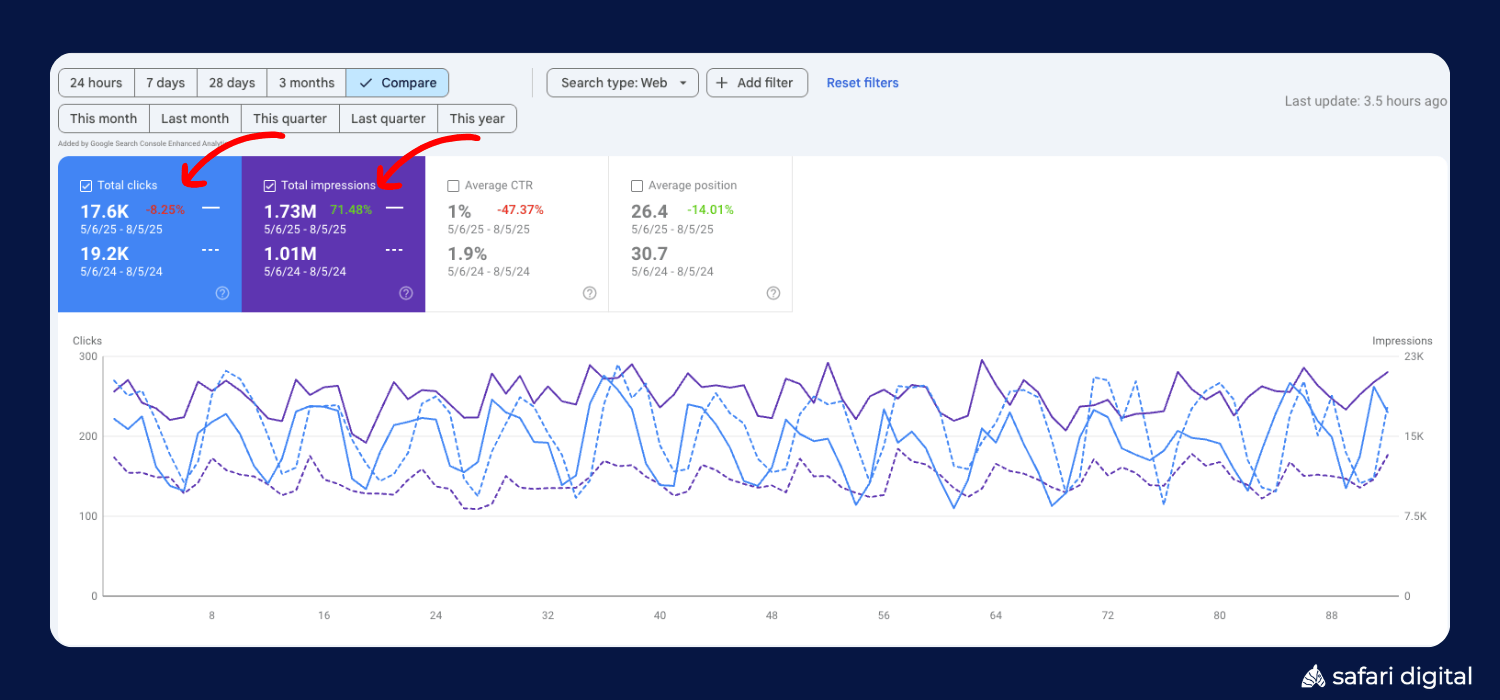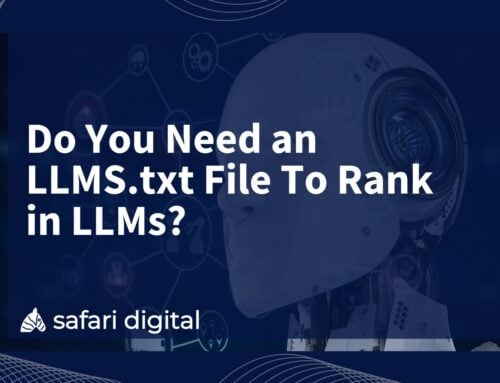Since launching back in 2024, Google has been ramping up the presence of AI Overviews (AIO) at the top of search results.
We tried to find some data on the percentage of search queries that trigger an AI Overview to appear in Google, but the reality is that things are changing so quickly that any number that we put here will be out of date in a matter of weeks.
As a benchmark, it’s somewhere around 50% of searches now feature an AIO as of mid-2025. As Google now starts to roll out AI mode, things are likely to change again.
But the question now is this: how do you view the clicks and impressions that are being generated by Google’s AI Overviews?
Can you see clicks from AIO in Google Search Console?
Ok, there are really two questions that we need to answer here.
1. Are organic clicks from Google’s AIO recorded in Google Search Console?
Yes, clicks from Google’s AIO are recorded in Google Search Console organic click reporting.
2. Can I see how many clicks are coming from AIO vs. traditional blue links?
No, as of August 2025, there is no way to separate clicks that come from Google’s AIO versus traditional blue links in organic search.
The general discourse from the SEO community is that clicks from Google’s AIO are not in Google Search Console – but this is sort of a half-truth. The important thing to clarify is that clicks from AIO DO appear in your Google Search Console reporting; however, they are not separated out from “normal” organic clicks so you can’t see where clicks and impressions are actually coming from.

This is where a lot of the frustration lies in the SEO community.
Why can’t we separate AIO clicks from “normal” organic traffic?
It’s pretty simple, we can’t separate AIO clicks from “regular” SEO traffic because Google has not separated the data in their reporting.
Why not?
Well, that’s a question for Google at this stage.
It is (by far) the most requested feature. Users are practically screaming out for it every time Google posts an update about AIO in search.
We would expect (hope) that we get the segmentation of this data at some point in 2025 but, as of mid-2025, there has been no word or indication from Google as to when this data will become available.
Why are organic impressions going up?
Most users will have noticed a significant increase in organic impressions recorded in Google Search Console since Google’s AIO started rolling out back in 2024.
Whilst the initial thought pattern was that there was a glitch or an error with reporting, the reason is pretty simple.
Google is counting impressions from both AI Overviews and page 1 separately, which means that when you rank on page 1 and you appear in AIO, you are receiving two impressions.
Why are organic click-through rates (CTRs) going down?
Google’s AIOs are increasing the number of impressions received for websites that appear in both the AIO and the traditional search results. If you appear on page 1 of Google and an AI Overview is showing where your website is also being cited, then you receive two impressions.
So part of the issue is that there are now more impressions on offer.
The second part of the reason why CTRs are going down is that the actual number of clicks that are generated from Google’s AIOs is, by all estimations, very low.
As we mentioned at the start, we have no way of currently knowing an average CTR for AIO when compared to the CTRs we expect from traditional blue links.
One of the things that we need to consider is that CTRs are also going down because users are now receiving information from the SERPs without the need to visit the web page.
This is giving rise to an increase in zero-click searches – an action where a user conducts a search, views the SERPs and then doesn’t click on anything.
TLDR – AIOs are lowering CTRs because:
- CTRs are decreasing because of double reporting on impressions from AIOs, and traditional search means that if you are appearing in both, then you are receiving two impressions.
- AIOs are, by all reckoning, increasing the number of zero-click searches where users are finding out all of the information that they need from the search results without clicking through to the website.
Let’s take a look at this client that we have been working with from the last year to break down what this actually looks like in practice.

| Metric | 2024 | 2025 | Difference |
| Clicks | 19.2k | 17.6k | -8.25% |
| Impressions | 1.01M | 1.73M | 71.48% |
| Click Through Rate (CTR) | 1.90% | 1% | -47.37% |
| Average Position | 30.7 | 26.4 | 14.01% |
Summary
- Clicks are down by 8.25%
- Impressions are up by 71.48%
- CTR is down by 47.37%
- Average position is up by 14.01%
So to break that down, here’s how we can look at those numbers. The most important metric for SEO from the above list would (in most cases) by clicks. The clicks are down. So by that logic, clicks are down = SEO agency has done a bad job. Which in previous years we would agree with.
The impressions are up because, as we discussed above, the client is now receiving double impressions for organic and AI overviews.
But here’s the thing: when we look at those numbers, we can also see that the average ranking (the average position across the website) has increased by 14.01%. That means that the average ranking for the keywords is better than it was last year – but the clicks are still down.
So the average ranking is better, the clicks are down because AIO are driving a higher number of zero-click searches, and the CTRs are dramatically down because of the increase in zero-click searches and the compounding effect of more impressions being on offer because of AIO.
How AIO are affecting Google Search Console numbers
As we discussed above, the main changes that we are seeing in Google Search Console numbers and reporting are as follows:
- Impressions are up because of double reporting on AIO + traditional blue links
- Clicks are down because of an increase in zero-click searches which are being driven by users finding more information from the SERPs through AIO and not clicking through to the website.
- The average CTR is down across the board because of the increase in zero-click searches and the amplifying effect of more impressions.
Final thoughts
Search is changing, which is to be expected. The missing piece at the moment is that we do not know the value of appearing in AIOs and whether it is something that we should be striving to achieve. Without understanding the value of AIOs – CTRs, conversions, etc. it’s difficult to make an educated conclusion on whether it is something worth striving for.
We expect that Google will, at some point, start to separate the data from AIOs in Google Search Console and Google Analytics so that we can see whether a click came from a traditional blue link or an AIO mention.
Until then, we are playing a guessing game as to the true value of AIO optimisation.






